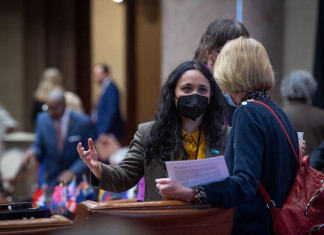Three area land conservation groups announced that they have secured a commitment of $2.56 million in federal funding to help preserve nearly 1,250 acres of productive farmland in Columbia and Dutchess counties.
Included in the package are two Red Hook farms: Kalina Farms on Rokeby Road and Jim Greig’s farm on Rockefeller Lane. The two farms combine for about 300 acres.
The farms are vitally important to the region because they produce local, healthy food and contribute to the local economy. Agreements already have been reached by Scenic Hudson, the Columbia Land Conservancy (CLC), the Dutchess Land Conservancy (DLC) and seven working family farms for the purchase of conservation easements (also called purchase of development rights) on the farms. The last step to completing the $5.3-million conservation effort will be accomplished through a combination of funding from Scenic Hudson, private donors and other public sources. The Town of Red Hook hopes to provide funds, in keeping with the almost $2 million it already has committed to farmland protection.
Speaking of the value of farmland preservation and this initiative, Town of Red Hook Supervisor Sue Crane said, “Red Hook’s long-standing commitment to preservation of our farms and rural landscapes has resulted in saving more than 5,000 acres. The community recognizes the importance of protecting our primary industry, farming. Simultaneously preserved are rural landscapes, wetlands, forests and diverse habitats, all of which inspire pride in the place we call home.”
The properties are important for their current farm operations, wildlife habitat, scenic qualities and because they are part of communities with strong agricultural economies. The farm properties include soils, forest land and wetlands that have been designated for special protections by the state Department of Environmental Conservation and the U.S. Fish and Wildlife Service. Some of the properties also provide habitat for northern harrier, a long-tailed hawk whose population has been in decline, as well as golden club, a threatened plant species.
Communities benefit powerfully from local farms. In addition to providing healthy food, family farms contribute to the area’s scenic beauty, rural character and economic opportunity. Farmland also helps keep local taxes in check by requiring fewer municipal services than farm owners pay in property taxes.
Despite these benefits, however, farms are at increasing risk. According to the 2007 Census of Agriculture, from 2002 to 2007, Columbia County lost over 13,000 acres of working farmland. In Dutchess County, nearly 10,000 acres were lost. As a reflection of this trend, the American Farmland Trust has placed the Hudson Valley on its list of threatened agricultural areas in the country.
“Hudson Valley farms remain vulnerable to many pressures at a time when valley and New York City residents consider it vitally important to secure a sustainable ‘foodshed,’ ” said Scenic Hudson President Ned Sullivan. “That’s why protecting them is a priority of Scenic Hudson’s ‘Saving the Land That Matters Most’ campaign.”
And DLC President Becky Thornton added, “DLC is proud to support our farmers—who work so hard, day in and day out, to keep the land in production—by helping them ensure their priceless farmland is protected. They are the producers of our local food and stewards of our incredibly rich rural agricultural landscape and some of our most incredible scenic views Red Hook has also been an incredible partner and a leader in protecting its local farms, and we couldn’t achieve the protection of these farms without the USDA’s wonderful support.”
Lands with conservation easements remain privately owned. Landowners participate voluntarily and can continue to live on and farm their property as well as pay property taxes. Farmers often use funds from the easement purchase to reinvest in their farm operations and expand production.







Facebook Comments